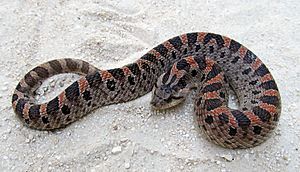Southern hognose snake facts for kids
Quick facts for kids Southern hognose snake |
|
|---|---|
 |
|
| Adult southern hog-nosed snake | |
 |
|
| Red phase southern hog-nosed snake | |
| Conservation status | |
| Scientific classification | |
| Genus: |
Heterodon
|
| Species: |
simus
|
| Synonyms | |
|
|
The southern hog-nosed snake (scientific name: Heterodon simus) is a harmless snake. It lives only in the southeastern United States. There are no different types (subspecies) of this snake.
Contents
About the Southern Hognose Snake
Adult southern hognose snakes are usually 35.5 to 61 centimeters (14 to 24 inches) long. They have a strong body and a wide neck. Their snout (nose) points sharply upwards.
Their back has a light brown, yellowish, gray, or reddish color. This is covered with dark spots. Smaller spots are found on their sides. Young snakes have a belly that is darker than the underside of their tail. As they get older, their belly usually turns a pale white.
Where They Live (Habitat)
Southern hognose snakes like dry, open, and sandy places. They can be found in dry river areas and open fields. They also live in flat areas with wire grass.
Geographic Range
This snake lives along the coast of the southeastern United States. You can find them from North Carolina down to Lake Okeechobee in Florida. They also live west to Mississippi.
What They Eat (Diet)
The southern hognose snake eats toads and frogs. They especially like barking tree frogs and ornate chorus frogs. They also eat spadefoots and lizards.
Reproduction and Life Cycle
Southern hognose snakes lay eggs. This means they are oviparous. Adult snakes mate from April through August.
The female snake lays 6 to 14 eggs at a time. These eggs have a thin, leathery, whitish shell. The eggs hatch after about 55 to 60 days. Each baby snake is about 15 to 18 centimeters (6 to 7 inches) long when it hatches.
Conservation Status
The southern hognose snake is listed as "Vulnerable" (VU) by the IUCN. This means it is facing a high risk of disappearing in the wild.
Experts believe there are fewer than 10,000 adult snakes left. Their numbers are expected to keep going down. This snake is considered to be in danger. The population trend for this species is decreasing.
Images for kids
See also
 In Spanish: Serpiente hocico de cerdo del sur para niños
In Spanish: Serpiente hocico de cerdo del sur para niños





